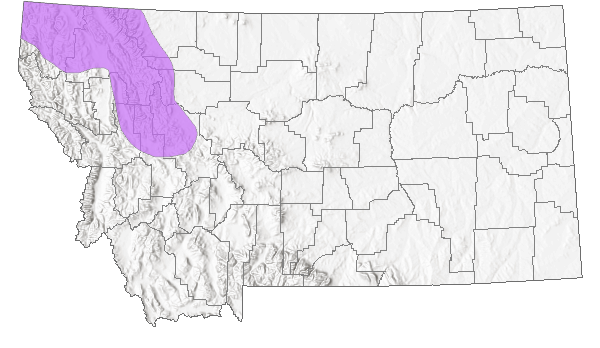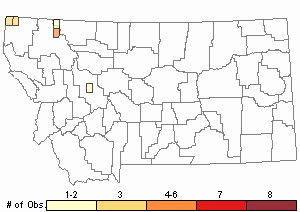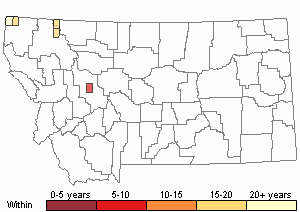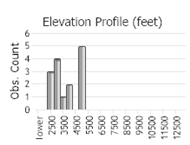View in other NatureServe Network Field Guides
NatureServe
Montana
Utah
Wyoming
Idaho
Wisconsin
British Columbia
South Carolina
Yukon
California
New York
Treelike Clubmoss - Lycopodium dendroideum
Other Names:
Lycopodium obscurum var. dendroideum, Dendrolycopodium dendroideum
State Rank Reason (see State Rank above)
Rare in Montana where the species has been documented from only a few sites in the northwest corner of the state. Trend data are unavailable. Known populations do not appear to be immediately threatened by any activities. Populations may be susceptible to negative impacts from fire.
- Details on Status Ranking and Review
Population Size
Score3 - Vey Small: Generally <2,000 individuals.
Range Extent
Score1 - Peripheral, Disjunct or Sporadic Distribution in MT: Widespread species that is peripheral, disjunct or sporadically distributed within MT such that it occurs in <5% of the state (<7,500 sq. miles or the combined area of Beaverhead and Ravalli Counties) or is restricted to 4-5 sub-basins.
Area of Occupancy
Score2 - Low: Generally occurring in 4-10 Subwatersheds (6th Code HUC’s).
Environmental Specificity
Score1 - Moderate: Species is restricted to a specific habitat that is more widely distributed or to several restricted habitats and is typically dependent upon relatively unaltered, good-quality habitat (C Values of 5-7).
Trends
Score0-2 - Stable to Moderate Declines:
CommentTrend data are unavailable. Habitat generally appears to be stable and it does not appear likely that severe declines have occurred, though it is possible that minor or moderate declines have occurred or may be occuring across the species' range in Montana due to drought conditions or other factors. Only 1 population has several years of data, which appear to show stable population levels.
Threats
Score1 - Medium: 11-30% of the populations are being negatively impacted or are likely to be impacted by one or more activities or agents, which are expected to result in decreased populations and/or habitat quality and/or quantity.
Intrinsic Vulnerability
Score2 - High Vulnerability: Very specific biological attributes, unusual life history characteristics or limited reproductive potential makes the species highly susceptible to extirpation from stochastic events or other adverse impacts to its habitat and very slow to recover.
CommentSusceptibility/vulnerability to fire and the potential for impacts to its' habitat from such events may be an important factor which increases the species' vulnerability.
Raw Conservation Status Score
Score
10 to 12 total points scored out of a possible 19.
General Description
Treelike Clubmoss resembles a miniature coniferous tree. The scattered, branched stems are 12-30 cm high and arise from deep rhizomes. Stems and branches are densely clothed in 6-8 ranks of narrow, sharp-pointed leaves that are 2-5 mm long. The spores, each subtended by a broadly lance-shaped bract, or sporophyll, are 2-4 mm long and are borne in dense, cone-like, brownish, 2-4 cm long spikes located at the tips of erect branches.
Phenology
Producing spores in July.
Diagnostic Characteristics
In other members of the genus, the rhizome is located above or just beneath the surface of the ground. The appearance resembling a miniature evergreen tree is distinctive.
Species Range
Montana Range
Range Descriptions

 Native
Native
Range Comments
In MT known only from Glacier and Flathead counties; Asia, AK to NL south to WA, WY and WV (Lesica et al. 2012. Manual of Montana Vascular Plants. BRIT Press. Fort Worth, TX).
Observations in Montana Natural Heritage Program Database
Number of Observations: 16
(Click on the following maps and charts to see full sized version)
Map Help and Descriptions
Relative Density

Recency



 (Observations spanning multiple months or years are excluded from time charts)
(Observations spanning multiple months or years are excluded from time charts)
Habitat
Moist, coniferous forest in the valley and lower montane zones.
National Vegetation Classification System Groups Associated with this Species
Forest and Woodland
Montane - Subalpine Forest and Woodland
Wetland and Riparian
Peatland
Riparian and Wetland Forest
Stewardship Responsibility
References
- Literature Cited AboveLegend:
 View Online Publication
View Online Publication Lesica, P., M.T. Lavin, and P.F. Stickney. 2012. Manual of Montana Vascular Plants. Fort Worth, TX: BRIT Press. viii + 771 p.
Lesica, P., M.T. Lavin, and P.F. Stickney. 2012. Manual of Montana Vascular Plants. Fort Worth, TX: BRIT Press. viii + 771 p.
- Additional ReferencesLegend:
 View Online Publication
View Online Publication
Do you know of a citation we're missing? Bursik, R. J., and R. K. Moseley. 1992. Forty-year changes in Hager Lake Fen, Bonner County, Idaho. Cooperative Challenge Cost-share Project, Idaho Panhandle National Forests and Idaho Conservation Data Center, Idaho Department of Fish and Game, Boise. 31 pp.
Bursik, R. J., and R. K. Moseley. 1992. Forty-year changes in Hager Lake Fen, Bonner County, Idaho. Cooperative Challenge Cost-share Project, Idaho Panhandle National Forests and Idaho Conservation Data Center, Idaho Department of Fish and Game, Boise. 31 pp. Lellinger, D.B. 1985. A Field Manual of the Ferns and Fern-Allies of the United States and Canada. Smithsonian Inst. Press. Washington, D.C. B85LEL01PAUS
Lellinger, D.B. 1985. A Field Manual of the Ferns and Fern-Allies of the United States and Canada. Smithsonian Inst. Press. Washington, D.C. B85LEL01PAUS Lesica, P., M.T. Lavin, and P.F. Stickney. 2022. Manual of Montana Vascular Plants, Second Edition. Fort Worth, TX: BRIT Press. viii + 779 p.
Lesica, P., M.T. Lavin, and P.F. Stickney. 2022. Manual of Montana Vascular Plants, Second Edition. Fort Worth, TX: BRIT Press. viii + 779 p.
- Web Search Engines for Articles on "Treelike Clubmoss"





